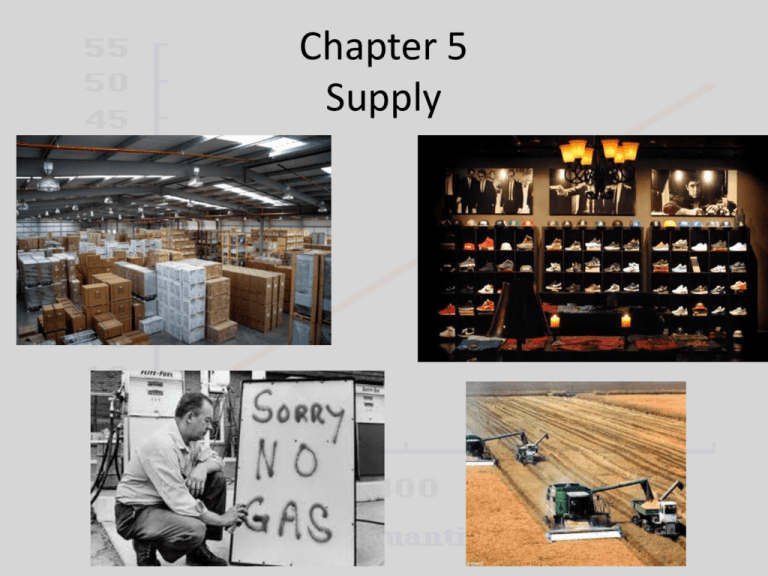Chapter 5 Slides
advertisement

Chapter 5 Supply Definition of Supply • Supply – the willingness and ability of producers to offer goods and services for sale. Law of Supply • Law of Supply – producers are willing to sell more of a good or service at a higher price. • If the price of a product falls producers will want to supply less of it. • This is a direct relationship. Supply Schedule Shows the law of supply in chart form. Individual Supply Schedule Price Per Pound of Tomatoes Quantity Supplied 2.00 50 1.75 40 1.50 30 1.25 20 1.00 10 .75 0 Supply Curve Shows the supply schedule in a graph form. Factors Affecting Supply • Input costs – the price of the resources used to make products • Labor Productivity – the amount of goods and services that a person can produce in a given time. • Technology – new discoveries in the production process means new manufacturing techniques. • Government Action (excise tax) – a tax on the production or sale of a specific good or service. • Producer Expectations – the expectation of a products price rising or falling will affect how much that producer is willing to produce. • Number of Producers – an increase in the number of producers of a certain product will increase demand. Costs of Production • At my pizzeria I charge 12.00 for a large pizza. • It cost me (overhead, fixed + variable costs) 4.00 to make a large pizza. • What is my overhead? Production Cost Schedules • Remember schedules in economics are charts. • Product Cost Schedule will show you the relationship between labor and production. Terms to Know • Marginal Product – the change in total product that results from hiring one more worker. • Specialization – each worker being hired focuses on a particular part of production • Diminishing returns – each new worker can actually cause a decrease in marginal product Product Schedule for making Pizza Number of workers Total Product Marginal Product 0 0 0 1 3 3 2 7 4 3 12 5 4 19 7 5 23 4 6 21 -2 As an owner what are your costs? • Fixed costs – examples include mortgage, insurance, utilities • Variable costs – wages, more material or overhead if production goes up • Total costs – the sum of fixed and variable costs Terms to Know • Marginal Costs – additional costs of producing one more item • Marginal Cost is calculated by dividing the change in total cost by the change in total product. Production Costs Schedule # of Workers Total Product Fixed Costs Variable Costs Total Costs Marginal Costs 0 0 40 0 40 --- 1 3 40 30 70 10 2 7 40 62 102 8 3 12 40 97 137 7 4 19 40 132 172 5 5 23 40 172 212 10 6 21 40 211 251 --- How do we earn the highest profit • Since we can stand to lose money by producing at a rate that is not efficient, we have to calculate how much profit we can make before we start to produce Simple Math!!! • Marginal revenue – the money made from the sale of each additional unit of output. Basically the price of an item. • Total revenue – a company’s income from selling its products. Total Revenue = P x Q • P = price / Q = quantity sold • Calculate by multiplying total product by marginal revenue Simple Math!!! • Calculating profit – total revenue minus total cost • Profit = total revenue – total cost Production Costs and Revenue Schedule # of workers Total Product Total Costs Marginal Costs Marginal Revenue Total Revenue Profit 0 0 40 ---- ---- 0 -40 1 3 70 10 12 36 -34 2 7 102 8 12 84 -18 3 12 137 7 12 144 7 4 19 172 5 12 228 56 5 23 212 10 12 276 64 6 21 251 ---- 12 252 1 $$$$$$$$$$$$$$$ • Profit Maximizing Output – level of production at which business realizes the greatest amount of profit. • Marginal Revenue = Marginal Costs • This is where you want to be and stay!!!!!!!!! Elasticity of Supply • Elasticity of supply – a measure of how responsive producers are to price change. • If a change in price leads to a change in quantity supplied, the supply is elastic. • If a change in price leads to a very small change in quantity supplied, the supply is inelastic. Examples Factors of Elasticity • The ability of a company to change production to respond to price changes. • Given enough time most companies will make their supply more elastic by expanding or downsizing.










